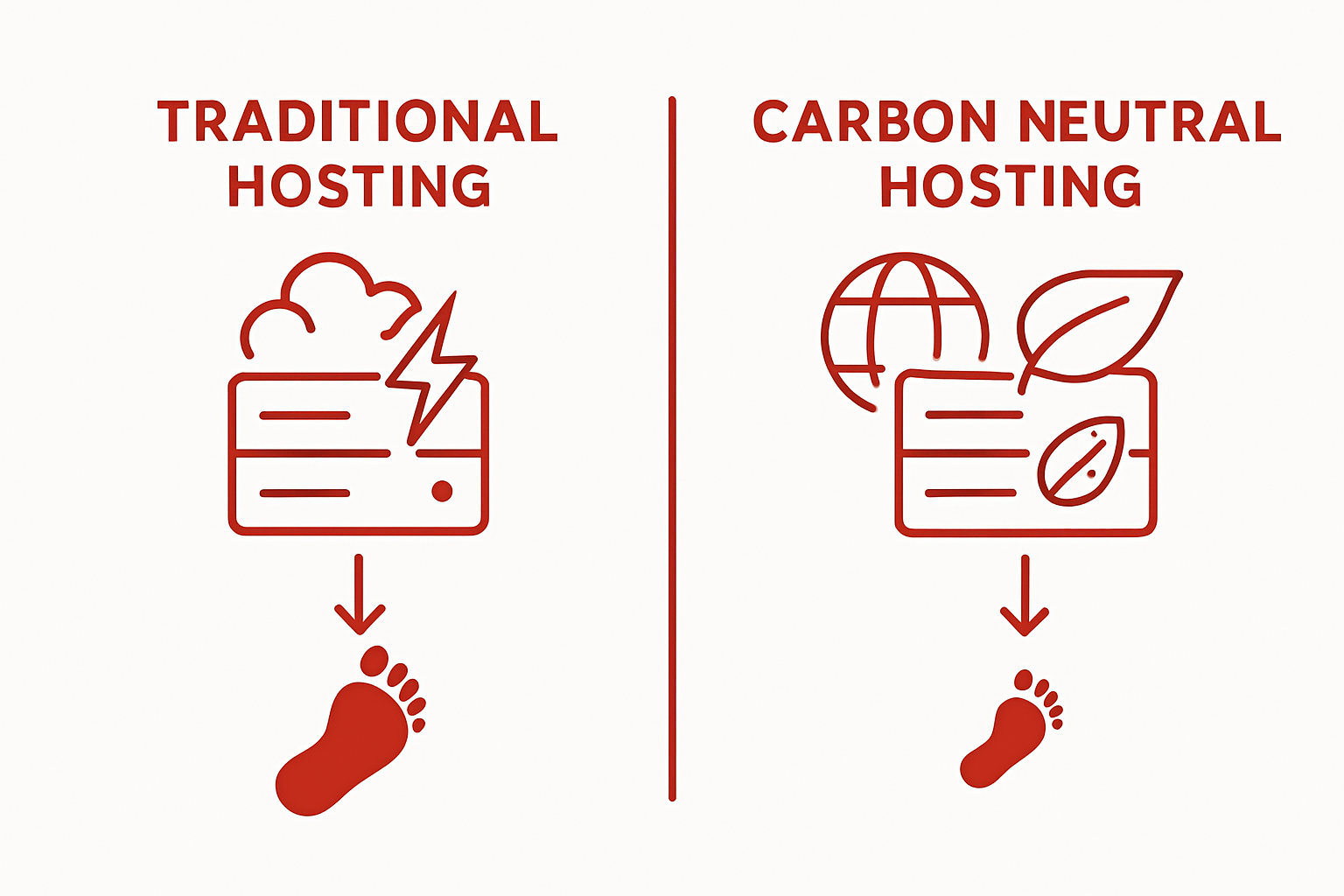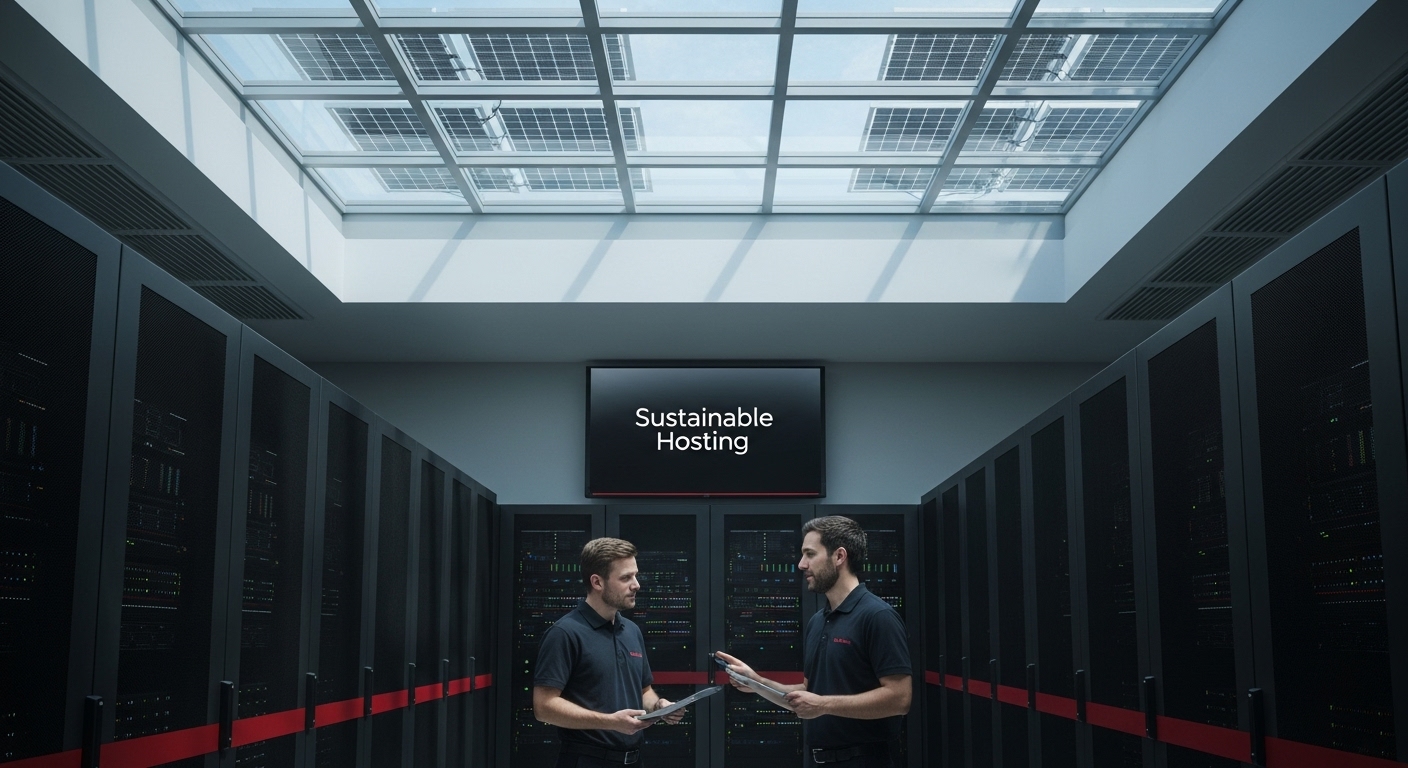What is Carbon Neutral Hosting and Why It Matters
Most people never give a thought to the carbon footprint left by the websites they visit and the emails they send. Yet the reality is striking. A single data centre can consume as much electricity as thousands of homes. Surprising as it sounds, the real solution for a greener internet does not just lie in cutting back on technology. The answer is in carbon neutral hosting, which flips the script on digital pollution entirely.
Table of Contents
- Defining Carbon Neutral Hosting And Its Importance
- Environmental Impacts Of Traditional Hosting Services
- How Carbon Neutral Hosting Works: Key Concepts
- Exploring The Benefits Of Carbon Neutral Hosting
- The Future Of Hosting: Trends Towards Carbon Neutrality
Quick Summary
| Takeaway | Explanation |
|---|---|
| Carbon neutral hosting offsets emissions | This approach balances greenhouse gases produced by data centres with equivalent reductions through environmental initiatives. |
| Transition to renewable energy is essential | Adopting renewable sources reduces reliance on fossil fuels, thereby minimising carbon footprints associated with hosting operations. |
| Measurement of emissions is crucial | Accurate tracking of all carbon outputs helps hosting providers identify areas for improvement and effectiveness in sustainability efforts. |
| Corporate responsibility enhances reputation | Companies that utilize carbon neutral hosting demonstrate commitment to sustainability, attracting eco-conscious clients and investors. |
| Technological innovation drives carbon neutrality | Advanced technologies like AI and renewable integration are key to enhancing energy efficiency in data centres. |
Defining Carbon Neutral Hosting and Its Importance
Carbon neutral hosting represents a groundbreaking approach in digital infrastructure that addresses the substantial environmental impact of web services. In an era where digital technologies consume significant energy, understanding what carbon neutral hosting entails becomes critical for environmentally conscious organisations and individuals.
What Exactly is Carbon Neutral Hosting?
Carbon neutral hosting is a web hosting strategy where data centres and digital service providers completely offset their carbon emissions through targeted environmental initiatives. According to the NSW Department of Primary Industries, carbon neutrality involves balancing produced greenhouse gases with equivalent emissions removed from the atmosphere.
Key characteristics of carbon neutral hosting include:
Below is a table summarising the key characteristics and typical strategies involved in carbon neutral hosting, providing a scannable reference for understanding its core components.
| Characteristic / Strategy | Description |
|---|---|
| Carbon emissions measurement | Assessing total greenhouse gas emissions from server operations, infrastructure, and energy use |
| Energy efficiency improvements | Upgrading equipment and processes to reduce overall power consumption and wastage |
| Carbon offset purchasing | Investing in verified projects (e.g., reforestation, renewable energy) to balance remaining emissions |
| Use of renewable energy | Direct sourcing or generating power from wind, solar, or other renewable resources |
| Transparent environmental reporting | Providing detailed public or client-facing reports on carbon footprint and sustainability efforts |
| Lifecycle considerations | Including emissions from hardware production, maintenance, and disposal in impact assessments |
| Support for environmental initiatives | Funding or participating in additional ecological projects beyond direct emissions offsetting |
- Measuring total carbon emissions from server operations
- Implementing energy efficiency improvements
- Purchasing verified carbon offset credits
- Investing in renewable energy infrastructure
- Transparent reporting of environmental impact
Why Carbon Neutral Hosting Matters
Web hosting generates substantial carbon emissions through continuous server operations, cooling systems, and energy consumption. A typical data centre consumes enormous electricity, often sourced from fossil fuel power plants. By transitioning to carbon neutral hosting, organisations can significantly reduce their digital carbon footprint.
Environmental Impact: Every webpage view, email sent, and cloud service accessed contributes to global carbon emissions. Carbon neutral hosting interrupts this cycle by ensuring that digital services operate without net negative environmental consequences. Swinburne University highlights that achieving carbon neutrality involves both reducing emissions and actively removing greenhouse gases from the atmosphere.
Moreover, carbon neutral hosting represents more than an environmental strategy—it signals a commitment to sustainable technological development. As businesses and consumers become increasingly eco-conscious, selecting carbon neutral hosting becomes a powerful statement of corporate responsibility and environmental stewardship.
Environmental Impacts of Traditional Hosting Services
Traditional web hosting services represent a significant and often overlooked contributor to global carbon emissions. These digital infrastructures consume substantial energy resources, creating an environmental footprint that extends far beyond what most people understand.
The Hidden Energy Consumption of Data Centres
Data centres, the backbone of internet infrastructure, operate continuously and require immense electrical power to maintain server operations and complex cooling systems. Research from the University of Technology Sydney reveals that these facilities can place considerable strain on local energy grids and natural resources.
Key environmental challenges include:
- Massive electricity consumption from non-renewable energy sources
- Significant heat generation requiring extensive cooling mechanisms
- Water-intensive cooling processes
- High carbon emissions from server infrastructure
- Electronic waste from frequent hardware replacements
Carbon Footprint of Digital Infrastructure
Every digital interaction generates carbon emissions. Streaming a video, sending an email, or maintaining a website requires energy-intensive server operations. A single data centre can consume electricity equivalent to thousands of households, making traditional hosting a substantial environmental concern.
The carbon impact extends beyond direct energy consumption. Manufacturing server hardware, maintaining temperature-controlled environments, and constantly upgrading technological infrastructure contribute to a complex web of environmental challenges.
This table compares the main environmental impacts associated with traditional web hosting, making it easier to visualise the different ways in which digital infrastructure contributes to ecological challenges.
| Environmental Impact | Description |
|---|---|
| Electricity consumption | Large amounts needed for servers and cooling, often derived from fossil fuels |
| Heat generation | Servers create excess heat, requiring intensive cooling systems |
| Water usage | Cooling processes frequently consume significant volumes of water |
| High carbon emissions | Continuous operation of equipment contributes to a substantial carbon footprint |
| Electronic waste | Regular hardware upgrades result in frequent disposal of outdated server components |
 The cumulative effect of these digital services creates a significant carbon footprint that often goes unnoticed by end-users.
The cumulative effect of these digital services creates a significant carbon footprint that often goes unnoticed by end-users.
Moreover, Australian business research indicates that many organisations remain unaware of their complete digital carbon emissions, highlighting the urgent need for transparent and sustainable hosting solutions. Understanding these environmental impacts is the first step towards developing more responsible digital infrastructure that balances technological advancement with ecological preservation.
How Carbon Neutral Hosting Works: Key Concepts
Carbon neutral hosting is a sophisticated strategy that transforms digital infrastructure from an environmental liability into a sustainable solution. By implementing comprehensive approaches to measuring, reducing, and offsetting carbon emissions, hosting providers can significantly minimise their environmental impact.
Measurement and Emissions Tracking
The first critical step in carbon neutral hosting involves precise carbon emissions measurement. Web hosting providers conduct thorough assessments of their entire operational carbon footprint, which includes electricity consumption, server operations, cooling systems, and hardware manufacturing. Climate Active’s Carbon Neutral Standard provides comprehensive guidelines for accurate emissions tracking.
Key components of emissions measurement include:
- Direct energy consumption from servers
- Indirect emissions from infrastructure construction
- Cooling and temperature management systems
- Network infrastructure carbon outputs
- Hardware lifecycle carbon contributions
Reduction and Offset Strategies
Once emissions are quantified, hosting providers implement two primary strategies: emissions reduction and carbon offsetting. Reduction involves transitioning to renewable energy sources, improving energy efficiency, and adopting green technologies. Carbon offsetting enables providers to neutralise remaining emissions by investing in environmental projects that remove equivalent greenhouse gases from the atmosphere.
Carbon offset projects might include:
- Reforestation initiatives
- Renewable energy infrastructure development
- Methane capture from agricultural systems
- Sustainable community development programs
- Investment in clean technology research
For businesses seeking to understand their digital environmental impact, our website carbon footprint checker provides valuable insights into potential improvements.
Ultimately, carbon neutral hosting represents a holistic approach to sustainable digital infrastructure. By meticulously measuring, reducing, and offsetting carbon emissions, hosting providers can transform their operations from environmental challenges to powerful agents of positive ecological change.
Exploring the Benefits of Carbon Neutral Hosting
Carbon neutral hosting transcends environmental responsibility, offering multifaceted advantages for businesses, technology ecosystems, and global sustainability efforts. By embracing these innovative hosting solutions, organisations can unlock significant strategic and operational benefits.
Environmental and Ethical Advantages
Carbon neutral hosting represents a proactive approach to ecological stewardship. According to the Australian Government’s Climate Change Department, these initiatives directly contribute to national and global emission reduction targets. The environmental benefits extend far beyond simple carbon offsetting.
Key ecological advantages include:
- Direct reduction of greenhouse gas emissions
- Support for renewable energy infrastructure
- Preservation of natural ecosystems
- Mitigation of climate change impacts
- Promotion of sustainable technological development
Business and Reputation Benefits
Beyond environmental impact, carbon neutral hosting offers compelling business advantages. Companies adopting these practices demonstrate corporate social responsibility and forward-thinking leadership. This commitment attracts environmentally conscious clients and positions organisations as innovative industry leaders.
Refer to the following table for a concise overview of the principal benefits offered by carbon neutral hosting, mapped across environmental and business categories for easy reference.
| Benefit Category | Specific Advantage | Explanation |
|---|---|---|
| Environmental | Reduction in greenhouse gas emissions | Minimises digital activities’ impact on the environment |
| Environmental | Support for renewables | Drives investment in and use of renewable energy sources |
| Environmental | Mitigation of climate change impacts | Actively supports efforts to counteract global warming |
| Business/Reputational | Enhanced brand reputation | Demonstrates commitment to sustainability, improving public image |
| Business/Reputational | Compliance with regulations | Helps ensure alignment with emerging environmental legislation and standards |
| Business/Reputational | Cost savings through efficiency | Greater energy efficiency may lower operational costs |
| Business/Reputational | Attraction of eco-conscious clientele and investors | Appeals to a market segment that prioritises ethical and sustainable practices |
Strategic business benefits encompass:
- Enhanced brand reputation
- Compliance with emerging environmental regulations
- Potential cost savings through energy efficiency
- Competitive differentiation
- Attraction of environmentally aware customers and investors
For businesses seeking comprehensive sustainable digital solutions, our sustainable web design services provide holistic approaches to ecological digital transformation.
Carbon neutral hosting is not merely a trend but a fundamental reimagining of digital infrastructure’s relationship with our planet. By prioritising sustainable hosting solutions, organisations can simultaneously reduce environmental impact, enhance operational efficiency, and contribute to a more sustainable technological future.
The Future of Hosting: Trends Towards Carbon Neutrality
The digital infrastructure landscape is rapidly evolving, with carbon neutrality emerging as a critical benchmark for technological innovation and environmental responsibility. As global awareness grows, hosting providers are transforming their operational models to align with sustainable practices and emerging climate objectives.
Technological Innovations Driving Change
Emerging technologies are revolutionising the approach to carbon neutral hosting. According to Infrastructure Australia, technological advancements are crucial in reducing carbon emissions across infrastructure sectors. Data centres are increasingly adopting cutting-edge solutions to minimise their environmental footprint.
Key technological trends include:
- Advanced liquid cooling systems
- Artificial intelligence for energy optimisation
- Renewable energy integration
- Modular and energy-efficient server designs
- Smart grid technologies for dynamic energy management
Regulatory and Market Drivers
Government policies and market dynamics are accelerating the transition towards carbon neutral hosting. Organisations are no longer viewing sustainability as optional but as a fundamental business requirement. The Australian Government’s commitment to net zero emissions by 2050 is creating a compelling regulatory environment that incentivises sustainable digital infrastructure.
Significant market transformations include:
- Mandatory carbon reporting requirements
- Financial incentives for green technology adoption
- Increased investor focus on environmental performance
- Consumer demand for sustainable digital services
- Emerging carbon pricing mechanisms
For businesses aiming to stay ahead of these technological shifts, our sustainable web design services offer comprehensive strategies for digital sustainability.
The future of hosting is intrinsically linked to environmental stewardship. As technological capabilities advance and regulatory frameworks tighten, carbon neutral hosting will transition from a competitive advantage to an industry standard, reshaping how we conceptualise digital infrastructure’s role in global sustainability efforts.

Ready to Shrink Your Digital Carbon Footprint?
If you have learned about the hidden environmental toll of traditional hosting in our article and feel concerned about the real impact your business leaves online, you are not alone. Many conscious organisations today want their digital presence to do good — not harm. The drive to minimise carbon emissions from your website and embrace carbon neutral hosting is more urgent now than ever, with both ecological responsibility and your reputation at stake.

Take the next step towards climate-positive change by choosing digital solutions that truly matter. At Marzipan, we create sustainable websites that align with your mission. Looking to understand your website’s carbon impact right now? Try our website carbon footprint checker for instant insights. Want a complete transformation? Explore our tailored sustainable web design services and lead your sector into a cleaner digital era. Now is the moment to act — discover how your website can support the planet and set your business apart.
Frequently Asked Questions
What is carbon neutral hosting?
Carbon neutral hosting is a web hosting strategy where providers offset their carbon emissions by implementing energy efficiency measures and investing in verified carbon offset projects, ensuring a net-zero impact on the environment.
Why is carbon neutral hosting important?
Carbon neutral hosting is crucial as it significantly reduces the carbon footprint of web services, addressing the substantial greenhouse gas emissions generated by traditional data centres and promoting sustainable technological development.
How do hosting providers measure their carbon emissions?
Hosting providers measure carbon emissions through a comprehensive assessment of their operations, including energy consumption, cooling systems, infrastructure construction, and the lifecycle impact of their hardware.
What are some strategies for achieving carbon neutrality in hosting?
Strategies for achieving carbon neutrality include reducing emissions through energy efficiency improvements, transitioning to renewable energy sources, and investing in carbon offset projects such as reforestation and sustainable energy development.







